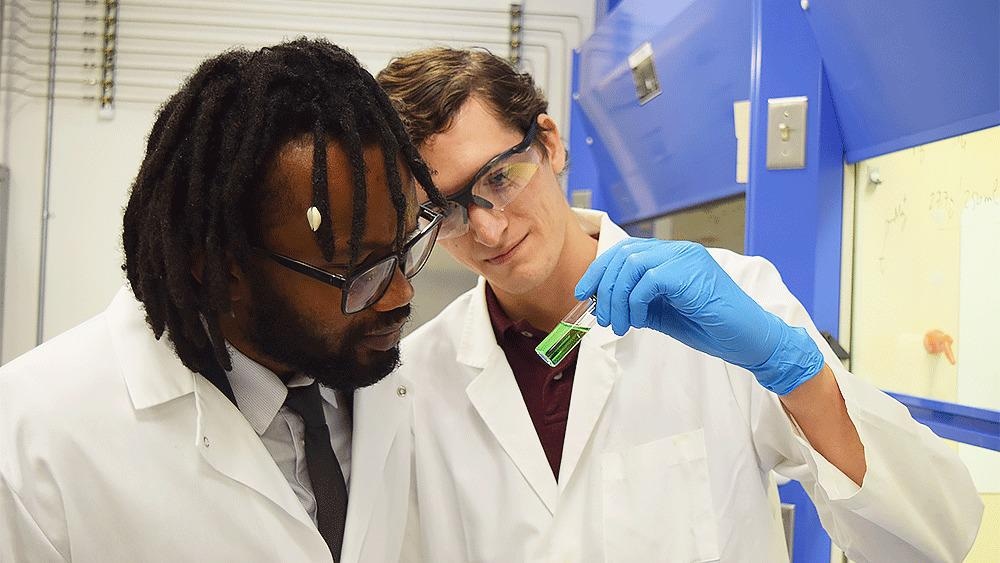Reviewed by Alex SmithApr 11 2022
Ammonia is widely used in fertilizer as it has the maximum nitrogen content of commercial fertilizers, making it vital for the production of crops. However, two carbon dioxide (CO2) molecules are generated for every molecule of ammonia made, adding to surplus CO2 in the air.
 Dr. Abdoulaye Djire (left) and Denis Johnson (right) analyze a coloring solution after an experimental run. A coloring solution is created after each nitrogen reduction reaction experiment, and the level of ammonia produced is indicated by how green the solution turns after a waiting period. | Image Credit: Texas A&M Engineering.
Dr. Abdoulaye Djire (left) and Denis Johnson (right) analyze a coloring solution after an experimental run. A coloring solution is created after each nitrogen reduction reaction experiment, and the level of ammonia produced is indicated by how green the solution turns after a waiting period. | Image Credit: Texas A&M Engineering.
Assistant professor Dr. Abdoulaye Djire and graduate student Denis Johnson along with others from the Artie McFerrin Department of Chemical Engineering at Texas A&M University have advanced a technique to create ammonia via electrochemical processes, helping to decrease carbon emissions.
This study aims to substitute the Haber-Bosch thermochemical method with an electrochemical method that is safer and more sustainable for the environment.
The scientists have reported their findings in the journal Nature Scientific Reports.
The Haber-Bosch process has been used to create ammonia since the early 1900s. This process functions through the reaction between atmospheric nitrogen and hydrogen gas. A disadvantage of the Haber-Bosch process is that it necessitates high temperature and high pressure, thus leaving a huge energy footprint.
The technique also necessitates hydrogen feedstock, which is extracted from nonrenewable resources. It is not sustainable and has undesirable repercussions on the environment, accelerating the need for new and eco-friendly processes.
The scientists recommend using the electrochemical nitrogen reduction reaction (NRR) to create ammonia from nitrogen and water found in the atmosphere. The advantages of using an electrochemical process include utilizing water to create protons and the ability to create ammonia at room pressure and temperature.
This process would theoretically necessitate lower quantities of energy and would be less expensive and more eco-friendly than the Haber-Bosch process.
The NRR functions by using an electrocatalyst. For this process to be successful, nitrogen has to bond to the surface and break apart to form ammonia. In this research, the team used MXene, a titanium nitride, as the electrocatalyst. This catalyst can easily be distinguished from others as nitrogen is already present in its structure, allowing for a more efficient ammonia creation.
It’s easier for ammonia to form because the protons can attach to the nitrogen in the structure, form the ammonia, and then the ammonia will leave out of the structure. A hole is made in the structure that can pull the nitrogen gas in and separate the triple bond.
Denis Johnson, Graduate Student, Artie McFerrin Department of Chemical Engineering, Texas A&M University
The scientists discovered that using titanium nitride encourages a Mars-van Krevelen mechanism, a prevalent mechanism for hydrocarbon oxidation. This mechanism employs a lower energy pathway that would enable higher ammonia production rates and selectivity due to the nitrogen from the titanium nitride catalyst.
Without carrying out any alteration to the materials, the scientists attained a selectivity of 20%, which is the ratio of the anticipated product formed compared to the unintended product formed. Their technique could potentially attain a higher selectivity percentage with alterations, building a new pathway to ammonia manufacture via electrochemical processes.
The Department of Energy has set a goal of a selectivity of 60%, which is a challenging number to reach. We were able to reach 20% using our material, showcasing a method that we might be able to take advantage of moving forward. If we upgrade our material, can we reach 60% soon? That is the question we will continue to work to answer.
Denis Johnson, Graduate Student, Artie McFerrin Department of Chemical Engineering, Texas A&M University
This study could possibly decrease the carbon footprint and worldwide energy usage on a greater scale.
In the future, this could be a major scientific reform. About 2% of the world’s total energy is used for ammonia production. Reducing that huge number would drastically reduce our carbon footprint and energy consumption.
Dr. Abdoulaye Djire, Assistant Professor, Artie McFerrin Department of Chemical Engineering, Texas A&M University
This study was financially backed by the Startup Research Fund. Other contributors to the study article are Eric Kelley from the chemical engineering department at Texas A&M, Jevaun Christie and Cullan King from Prairie View A&M University, and Brock Hunter from Auburn University.
Journal Reference:
Johnson, D., et al. (2022) Ti2N nitride MXene evokes the Mars-van Krevelen mechanism to achieve high selectivity for nitrogen reduction reaction. Nature Scientific Reports. doi.org/10.1038/s41598-021-04640-7.